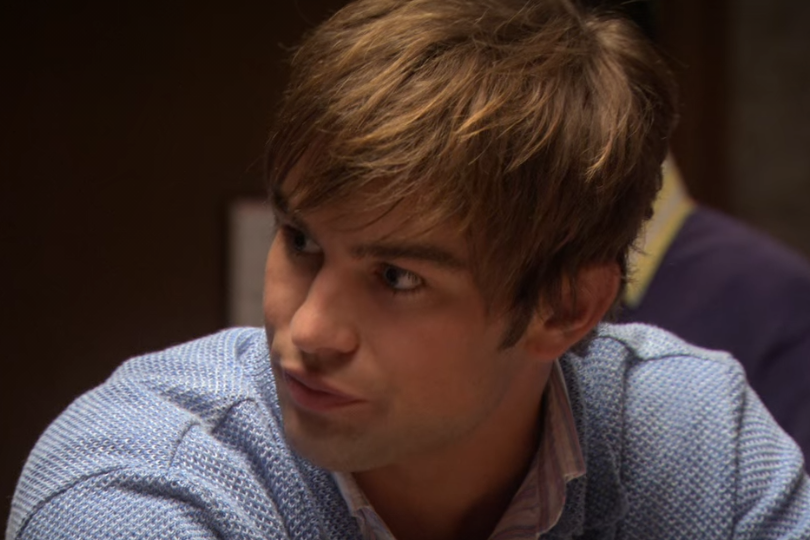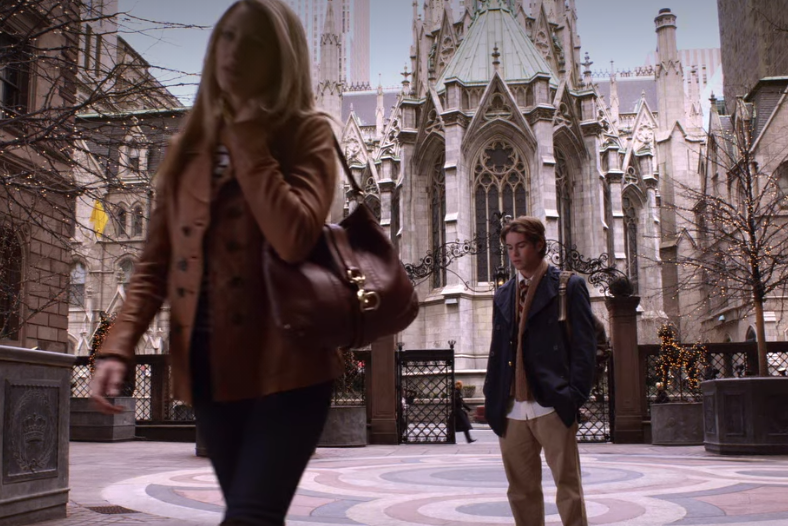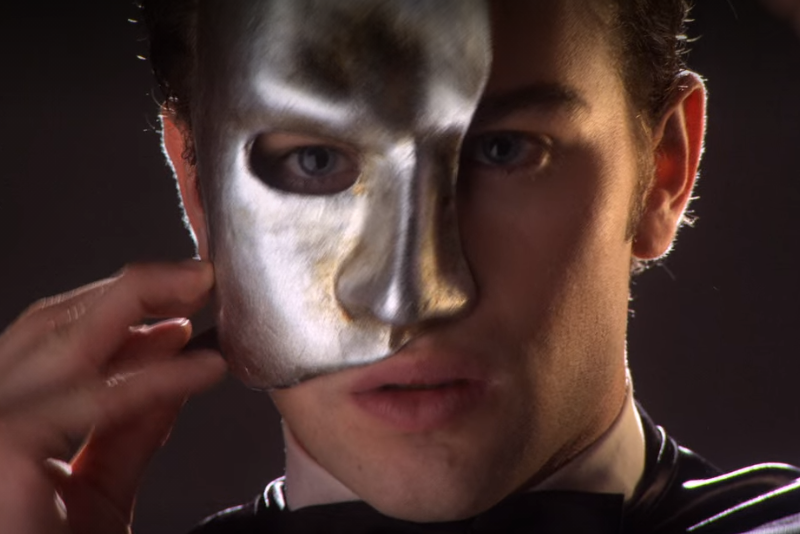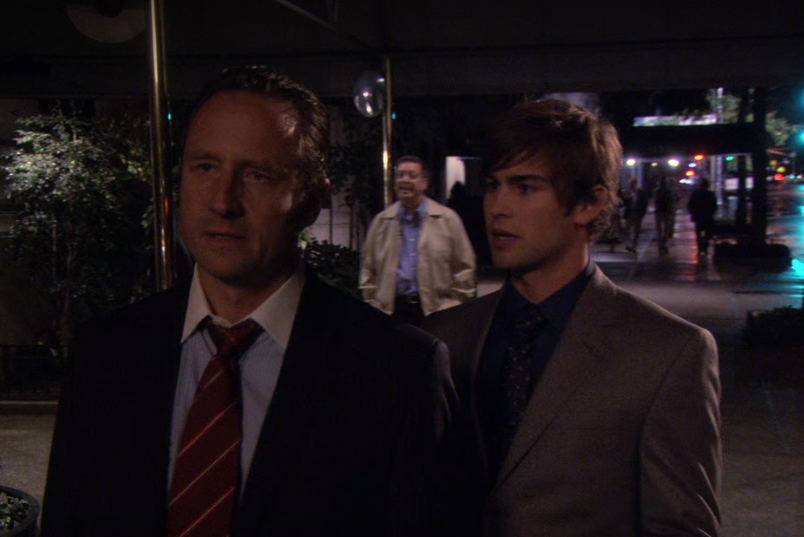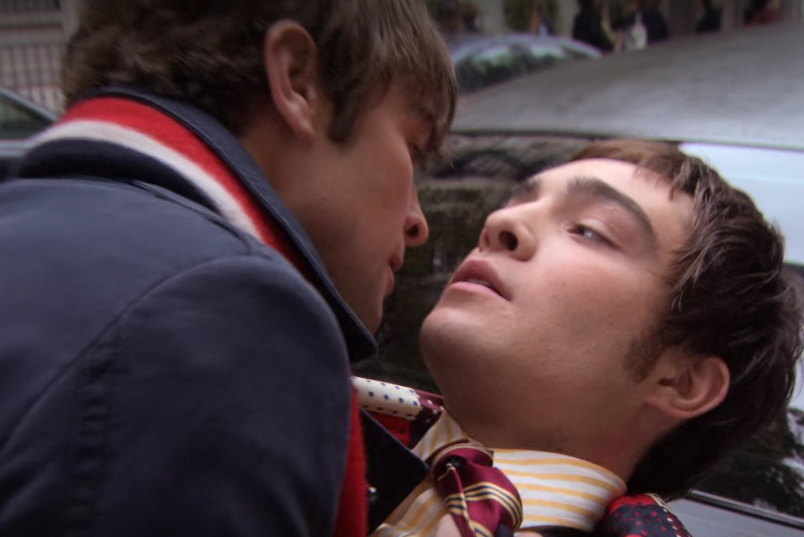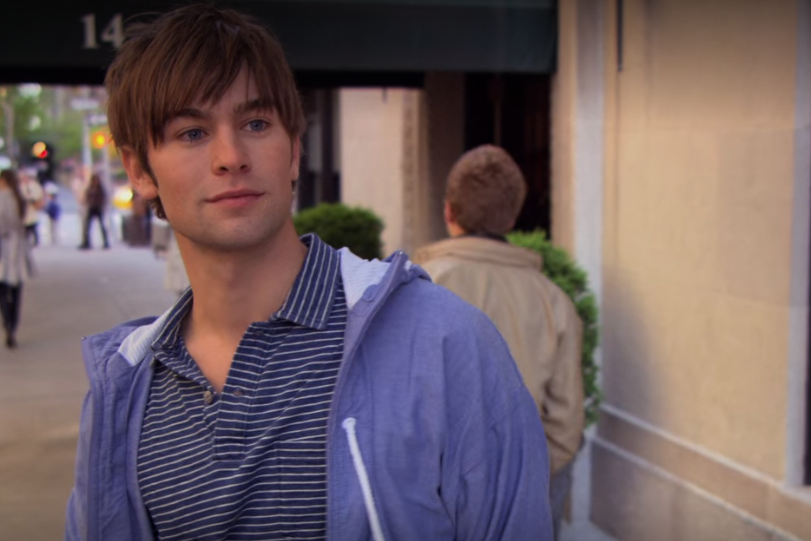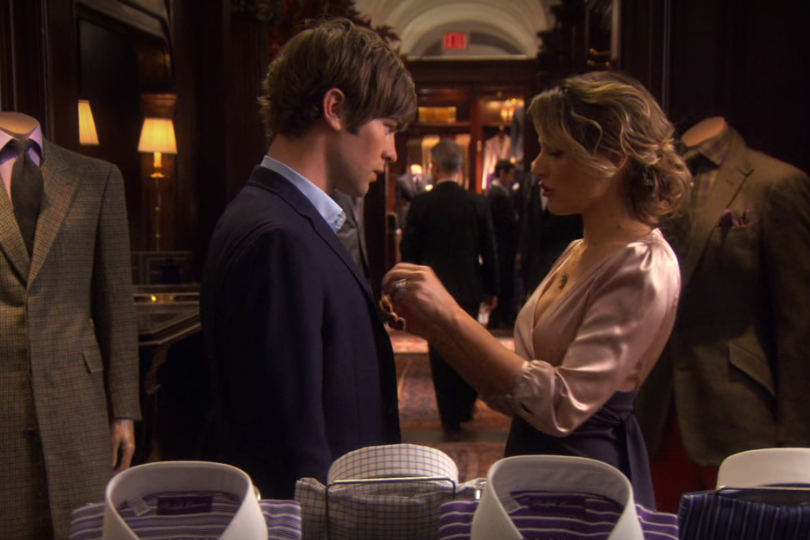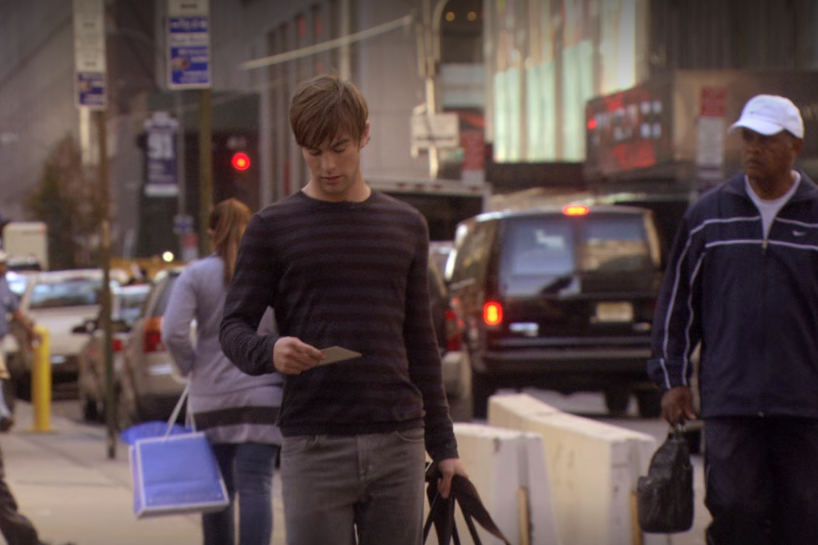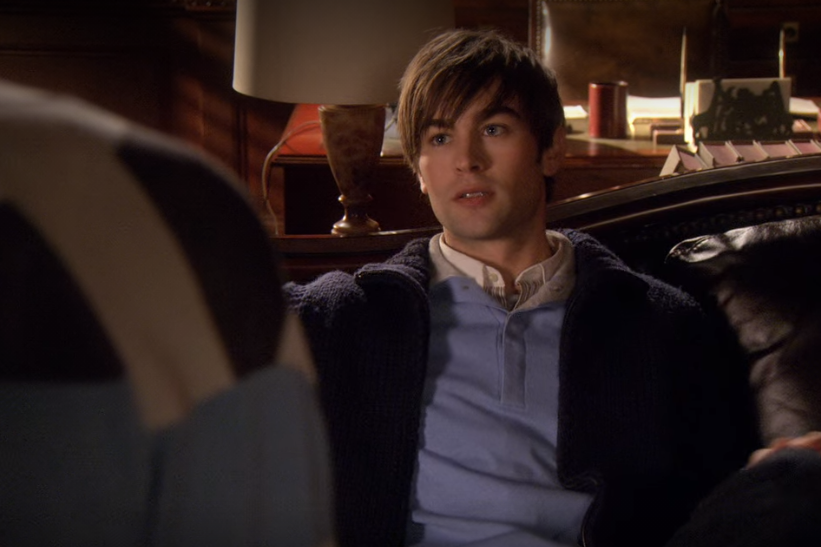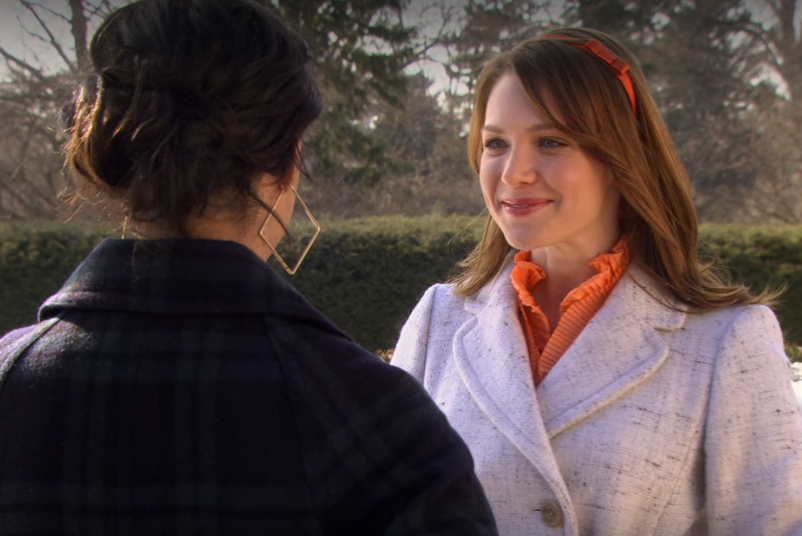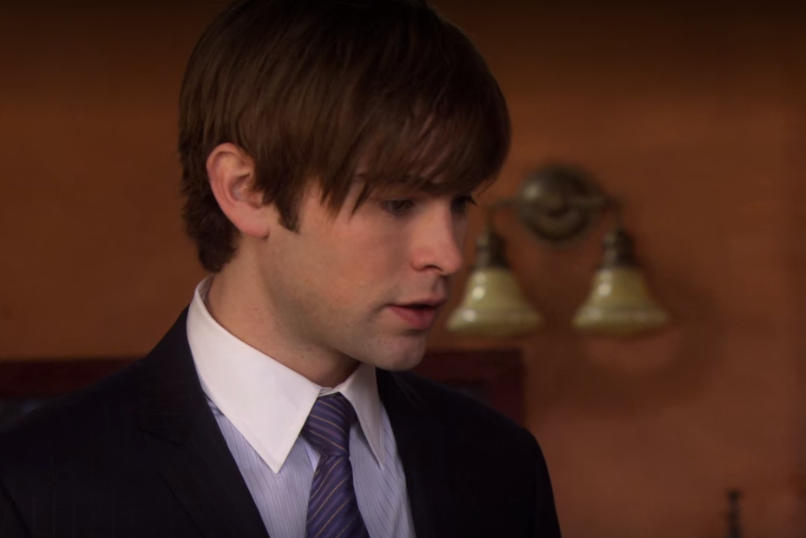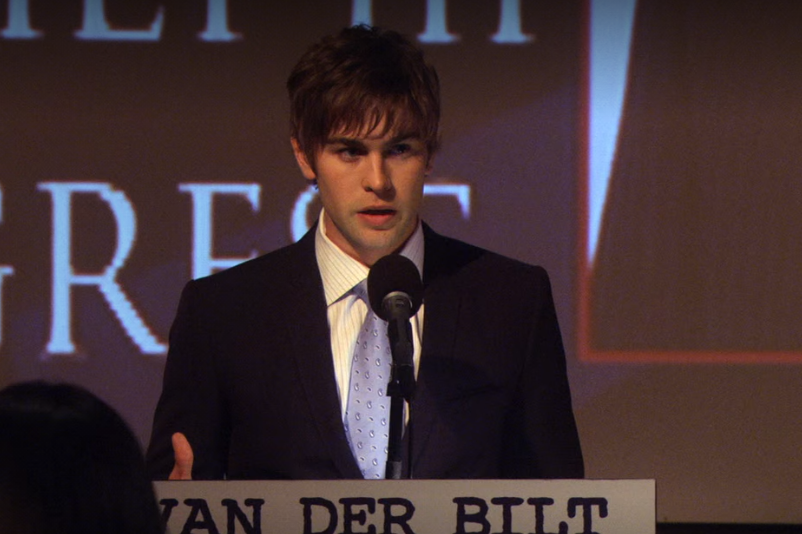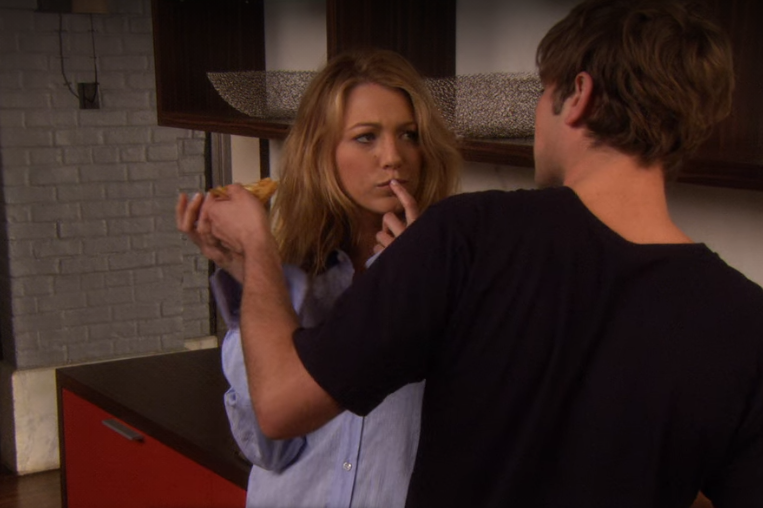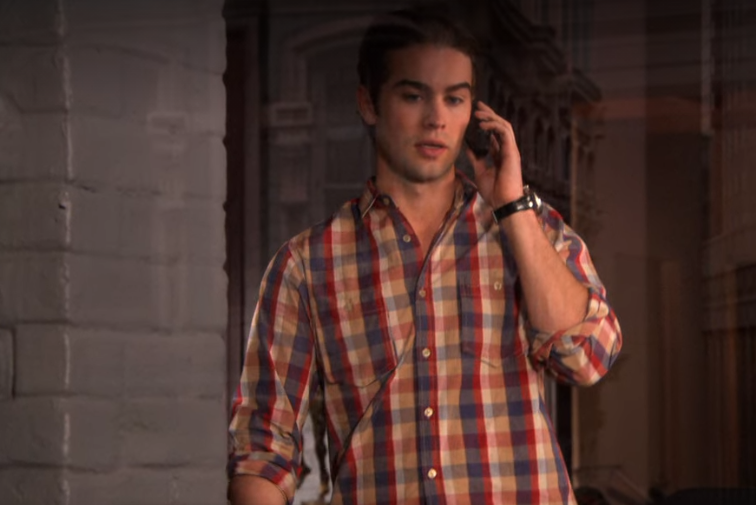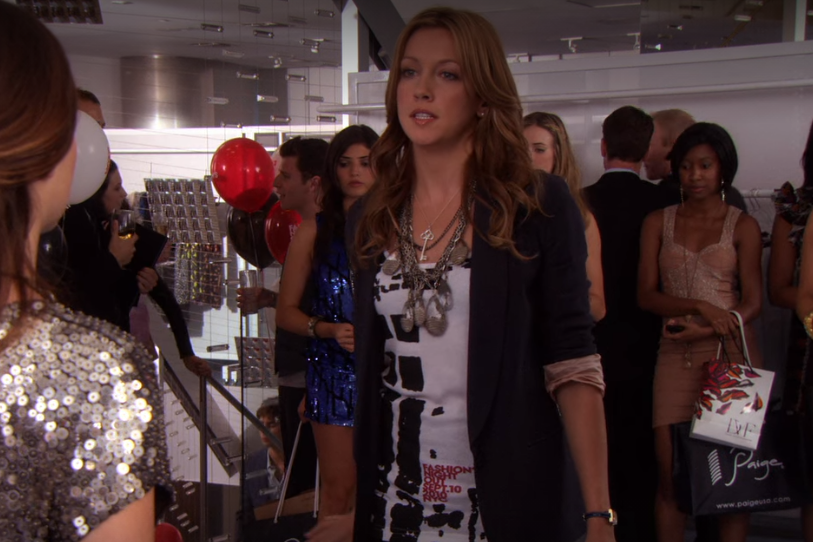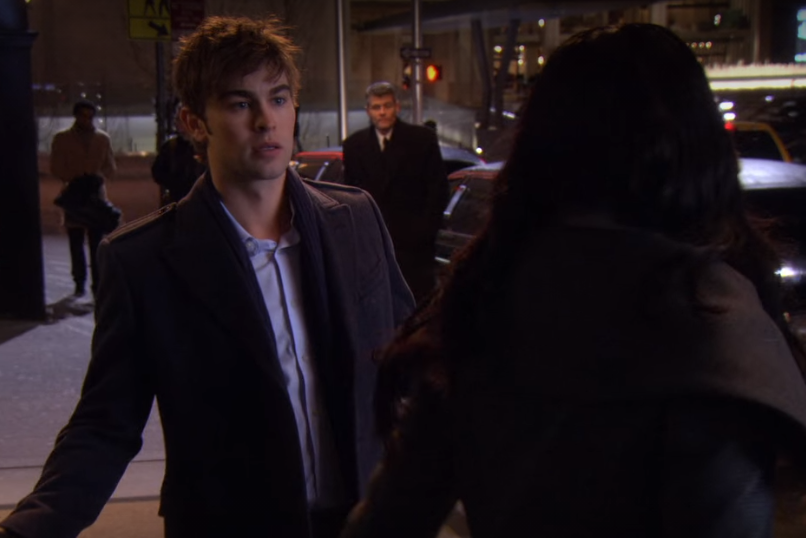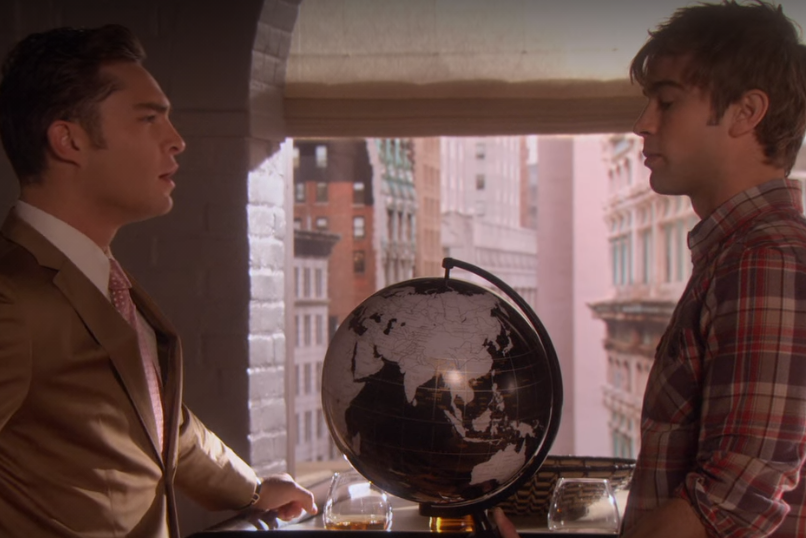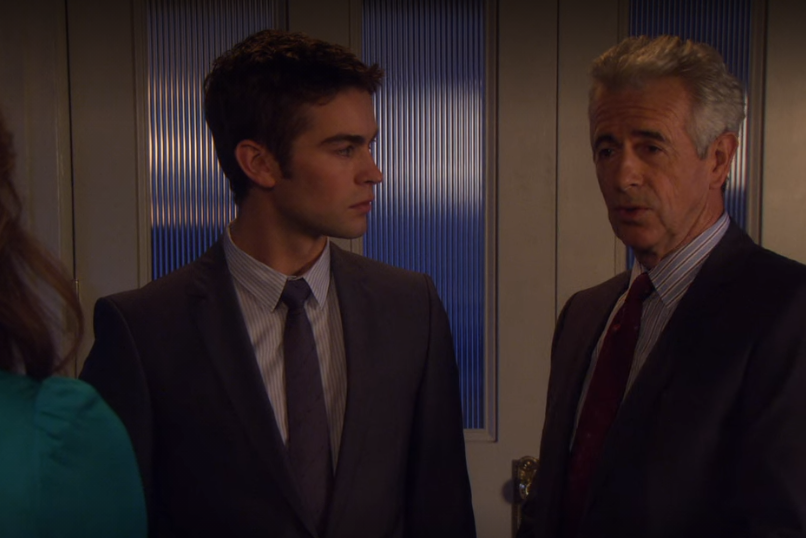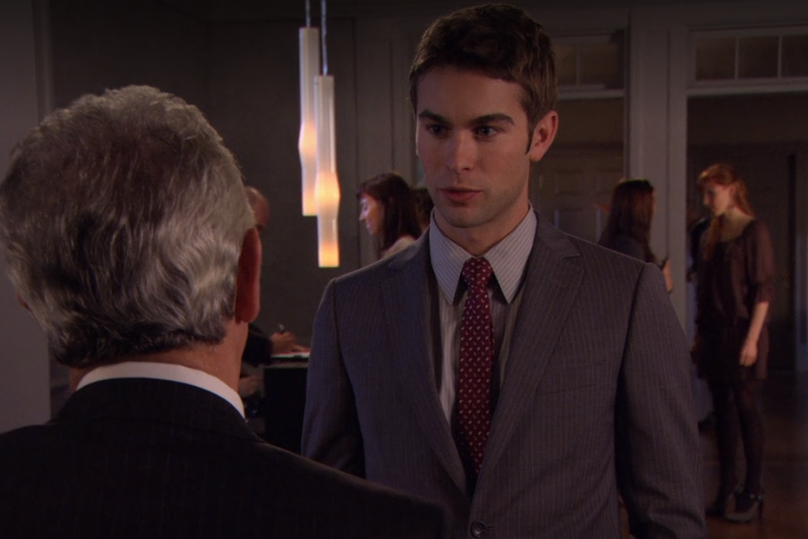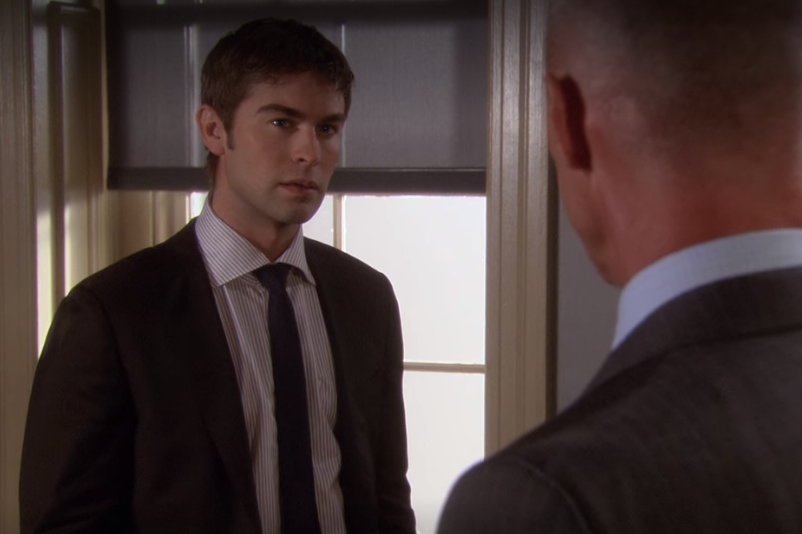The Nepotism of Nate Archibald
Originally published 12/17/2020 on Substack
[This profile contains discussion of sexual coercion.]
Here we are! My second profile! Just like Taylor Swift, I can create two of the same thing in a year.
After the intricacies of Jenny Humphrey’s costume design, I thought I’d need someone a little simpler, a little less varied in their style. And, while I mean this with all the affection in the world, the first character who came to mind was Nate Archibald, played by Chace Crawford.
Yet when I looked back through my notes, when I rereviewed episodes, I realized there is more complexity, more emotional weight to Nate’s costume design than I originally thought. Granted, the individual pieces aren’t particularly daring. With the exception of Rufus’s jewelry and Chuck Bass’s everything, the Gossip guys’ clothing choices don’t push sartorial or gender boundaries, and I wouldn’t expect them to. Most straight white cis men circa 2007 didn’t.
Nate, after all, is the idealized mid-2000s teen heartthrob: swoopy bangs, pretty face, shiny teeth, thin body. (I recently learned that Chace Crawford both worked at an Abercrombie store and modeled for Hollister—two mall brands that marketed the era’s “desirable” teen aesthetic.) Of course, very few seventeen-year-old boys look like the twenty-two-year-old Crawford (as he was in the show’s premiere), and that was, in part, the point. Nate Archibald was supposed to be the “quintessential teenage girl dream . . . that guy who’s very handsome, his hair’s a little bit long, and his shirt’s untucked, and his tie’s askew” (“5 Years of Iconic Style”). He was the beautiful male “counterpart to Blair [Waldorf]” (“Gossip Girl Couture”), the perfect boyfriend who’s not so perfect.
As the show went on, Nate became the go-to love interest for female characters, both main and side. I can almost hear the writers’ room conversations: How do we create more drama in Main Female Character’s love life? Nate! How do we keep Side Female Character relevant in the Upper East Side world? Nate!
While all the main female characters are regularly sexually objectified and shamed by the show, by the other characters, Nate is the only main male character who shares this fate. “Nate doesn’t have a type, like Derek Jeter,” says one of Blair’s minions, and the viewers, maybe even Nate himself, start to believe it. But the truth is, Nate does have a very specific type; he looks to his romantic relationships to figure out who he should be: what he should do with his life, how he should dress. And this pattern, Oedipally enough, begins and ends with his family, the Archibalds and the van der Bilts. (Please note that I know how to spell Vanderbilt; this is the very silly way that the show styles the name.)
Season One
When the first episode opens, Nate is a junior at St. Jude’s School for Boys. He reluctantly allows his parents to dictate every aspect of his life, from his college path (Dartmouth, then law school) to his girlfriend (Blair) to his clothes. Eric Daman imagined that Nate’s wardrobe was chosen by his mother, Anne Archibald, née van der Bilt, and so his clothing reflects her WASP-y taste, her ideal image of her son: He wears preppy, sporty brands—“Ralph Lauren or Abercrombie . . . J. Press, Brooks Brothers” (“Couture”)—in various shades of blue (according to Daman, to play off both Nate’s love of yachting and Crawford’s eye color). I picture Anne standing in Brooks Brothers, holding up a blue button-down, and saying, “Yes, that will go nicely with Nathaniel’s eyes.”
Because Nate has no investment in these clothes, just as he has no investment in the future his family has laid out for him, he puts no thought into wearing them correctly. As Daman explains:
[Nate’s clothes] were all the best of the best, and he didn’t really care . . . he wears everything kind of rumpled and lived in. You’ll never see Nate in a perfectly pressed shirt. Nate has a Loro Piana $500 dress shirt but doesn’t really care about it (“Couture”).
Let’s take, for example, the first appearance of Nate’s uniform (1.1): untucked shirt, loose tie, slouchy khakis. Unlike the female characters, the male characters’ uniforms remain uniform, and so Nate repeats this sloppy outfit throughout his junior and senior years—in the former, often with this navy-blue trench on top. Nate’s mother can afford to buy him another coat, but perhaps Nate doesn’t care enough to try a different style—or perhaps Anne wouldn’t dare let him.
In this very outfit, Nate asks his best friend, Chuck Bass, “Do you ever feel like our whole lives have been planned out for us? We’re just going to end up like our parents?” (Season six, from far off, screams, “YES!!!”) Chuck dismisses his concerns, but I can’t help but think about one of Daman’s style references for Nate: the Kennedys (“Couture”). Like a Kennedy son, Nate is tied to a wealthy “All-American . . . East Coast” (“Couture”) political dynasty, groomed for the future that his parents (and later, his van der Bilt grandfather) have imagined. Sometimes, Nate pushes back, and sometimes he lets the tides carry him, believing it is his own will, and not the current, that is taking him.
At the beginning of season one, Nate starts pushing back, looking for any model for a different life that he can find. In episode four, Nate idolizes Carter Baizen, an older St. Jude’s student who cut his Upper East Side ties to travel the world—at least until Carter sets Nate up in a poker game.
Still, you can see the pull Carter briefly has on Nate; at the game, the dark blues and thin stripes of Nate’s shirt mimic those in Carter’s. Nate wants Carter’s freedom, and yet he doesn’t know exactly why or for what purpose: As Chuck asks him, “That dream of yours, you know, what is it really? Because I hear you talk about how you don’t want to go to Dartmouth, and how you don’t want to follow in your father’s footsteps, but what exactly do you want?” Nate has no answer, except that it’s not “this.”
“This” being, too, his relationship with Blair. Though Nate doesn’t love her, he feels obligated to stay with her for his family: his father, Howard, is closing a deal with Blair’s mother to take Eleanor Waldorf Designs public. To the masquerade ball (1.6), where Nate confesses his love for Serena van der Woodsen while he’s supposed to be finding Blair, he wears a Phantom-like mask, covering only one side of his face. The mask does little to conceal his identity, just as his heart does little to guard his true feelings.
Nate soon discovers that his father is using cocaine, and when Anne finds the stash, Howard is quick to pin it on his son. Even after Nate tells his mother the truth, she rationalizes his father’s addiction with Nate’s own “misbehavior”: “If you hadn’t been so difficult lately . . . all this business with Dartmouth, your issues with Blair” (1.7). She insists that they attend their celebratory dinner with the Waldorfs, telling Nate, “Please wear a tie.” His participation in his family is contingent on his ability to dress in a socially appropriate manner, a respectable outside signaling a harmonious inside. For the dinner, he follows his mother’s instructions, choosing an Archibald-approved dark blue tie and shirt, a gray suit on top.
As it turns out, Howard has been dabbling in more illegal activities than cocaine use: he’s arrested for embezzlement and fraud. To try to save Howard’s deal, Anne encourages Nate to give Blair her engagement ring—the same ring Cornelius van der Bilt gave his bride, a symbol of their family’s long, rich legacy in New York. Nate refuses, and he and Blair break up.
By Thanksgiving (1.9), Howard has been released on a million-dollar bail. He and his family dine on Citarella catering, having been disinvited from the Waldorfs’ dinner. After Howard overdoses, Anne accuses Nate of blaming her for his father’s addiction: “All I’m guilty of is trying to make [your father’s] life easier. . . . My father set him up with his own firm. He gave us the house that we live in, the Hamptons, the boat. He’s never had to earn a dime. . . . All he had to do was sit behind a desk, put on a suit, and not get arrested.” The same life that was once set up for Howard is now being set up for Nate, the expectation being that he will assume the role like a costume: put on a suit, wear a tie.
Even his relationship with Blair requires costuming. Like Nate, Blair favors preppy styles, but because she picks most of them herself, they are much more suited to her personality: more studious and fastidious than Nate’s. In episode ten, Nate notices that Blair (now secretly sleeping with Chuck) has relaxed; he’s drawn to her newfound ease. He asks to escort her to cotillion, telling her that he recently found the sweater in which she once sewed her pin. He pulls up the cuff, revealing a tiny gold heart. “I sewed it there,” Blair says, “so you’d always have my heart on your sleeve.” Though the sweater was likely bought by Anne, Blair has made her own mark on it, the heart itself imprinted with an anchor, a symbol of her love for Nate, or at least her preppy image of him. Blair agrees to attend cotillion with Nate, and afterward, they begin dating again.
In episode thirteen, however, Nate learns that Chuck and Blair had sex, and he confronts his friend outside St. Jude’s. Both are dressed in their school uniforms, Chuck wearing his signature patchwork scarf, Nate with a striped one over his usual blue trench. Nate has never worn this scarf before, while Chuck wears his all the time, and so the pieces serve to compare and contrast the two characters. Chuck’s scarf is more dandy and elaborate than Nate’s simple, preppy piece, and yet their scarves share the same color palette: the navy, white, and red of the girl they will both soon abandon.
As the season goes on and Nate avoids Chuck, he begins dating Vanessa Abrams. His outfits evolve into a more casual, relaxed version of his usual style. Take, for example, the look he wears to drop off his old SAT prep books with Dan Humphrey: a navy-blue Henley layered under an open blue button-down. His relationship with Vanessa, a filmmaker from an artistic family, shows him the different expectations that families can have: “Just like going to an Ivy is your family’s way,” Vanessa says, “not going to college is mine” (1.15).
By the finale, Nate is ready for the Hamptons in an easy summer look: a striped blue polo, blue windbreaker, and shorts. However, his family troubles are only just beginning: Howard avoids prison time by running away to Dominica, aided by Anne.
Season Two
In the premiere, we discover that Nate has spent the summer sleeping with a married duchess, Catherine Beaton. Their age difference alone creates a huge power imbalance—Catherine is two decades older than seventeen-year-old Nate—but to make matters more complicated, Catherine begins paying Nate for sex after the Archibald assets are frozen.
Anne usually favors oatmeal-colored separates, but when she tells Nate that her father, William van der Bilt, refused to help with their finances, she wears a blue visor and sapphire heart-shaped necklace (2.2). These touches not only echo Nate’s own blue polo—likely purchased by Anne—but also hint that the color blue has always symbolized the van der Bilts, not the Archibalds. After all, a van der Bilt is what Anne wants Nate to be, what she always wanted his father to be: well kept and well dressed, a man of money and ease.
Though his family’s money may be in limbo, Nate now has another woman buying his clothes: In episode three, Catherine takes Nate on a shopping trip, telling him, “Ralph Lauren adores you.” As she dresses Nate in a navy suit and light blue button-down, Catherine holds her knowledge of Howard’s location over his head. “I told you that in confidence,” Nate says.
“You told me that in bed,” she replies.
Catherine’s blackmail looms over Nate until the duke learns of the affair and sends his wife back to England, Howard safe but the Archibald finances still in ruin.
Back in the city, Dan discovers that Nate is squatting at the seized Archibald house and invites him to move in with the Humphreys. Now removed from both Anne and Catherine, Nate assumes another woman’s taste, and by episode nine, he’s subtly dressing in Jenny’s rocker style: above, he wears a dark gray cardigan over his usual blue T; later, Jenny pulls him a suit for her fashion show—an uncharacteristic black suit with a skinny dark tie, likely Dan’s. After Dan sees a photo of Nate and Jenny kissing, he confronts his friend, angry that Nate pursued a romantic relationship with Jenny while living at their loft.
“Don’t act like I’m some creepy older guy,” Nate replies, and Dan shoots back, “No, you’re the guy who traded sex for money.” In the moment that follows, you can see the shame that passes between them—Nate, for taking the money; Dan, for using Nate’s actions as ammunition. “I’m sorry I didn’t say anything about Jenny,” Nate says, “but you have no right to judge me.” Nate’s right to defend himself: there’s nothing inherently wrong with accepting money for sex; what is wrong is Catherine creating a power imbalance with her age and wealth and knowledge of Howard’s whereabouts, all of which made it impossible for Nate to consent to their exchange.
By the time Nate moves out of the Humphreys and back to his mother’s house in the Hamptons, he’s wearing a gray-striped shirt with gray-wash jeans—the most Jenny look of them all. (Appropriate, considering the symbolism Jenny’s own wardrobe carries for her shame and sexual assault.) Though Nate has left Jenny behind, he still harbors feelings for her. Thinking Jenny is no longer interested, he reunites with Vanessa.
At Thanksgiving (2.11), Howard returns to take Nate and Anne back to Dominica; he plans to use his family to demand ransom from the van der Bilts. Nate convinces his father to turn himself in instead, and the Archibald assets are finally unfrozen, their Upper East Side house inhabitable again.
Bubble Episode
Nate’s bubble episode was an easy choice: 2.19, “The Grandfather,” aka the first appearances in the flesh of William van der Bilt and Nate’s older cousin Tripp. At the beginning of the episode, Tripp arrives at the Archibald house in a blue plaid shirt and lemon sweater; he’s a van der Bilt for sure, but not quite the prodigal son that Nate is, dressed in four layers of blue: sweater and polo and button-down and T-shirt.
Tripp asks Nate to attend a van der Bilt anniversary gathering at their grandfather’s mansion, and though Nate hasn’t yet forgiven William for abandoning him and his mother, Dan and Vanessa convince him to go. Vanessa’s encouragement is made tangible in this scene, her look much preppier than usual: a cardigan in many stripes of blue.
Grandfather, of course, is also dressed in the color: a pale blue cowl-neck sweater with a collared shirt and tie underneath; even his lanyard is blue. Suddenly, his influence over Anne, over Howard, over Nate, is obvious; he is the originator of Nate blue, the referee to his grandchildren’s lives.
As the boys play touch football, Vanessa chats with Tripp’s fiancée, Maureen. Vanessa should be worried from the start: Maureen is dressed like an older Blair, a ruffled orange blouse and matching bow headband. “Everyone loves you,” Maureen tells Vanessa. “They’re probably already designing the campaign posters. . . . And with Nate’s charm and your background . . .” Vanessa, the only main character of color, questions this microaggression, though Maureen insists that Vanessa’s background is “activist.”
A career in politics, Maureen says, is a “van der Bilt birthright,” or at least a van der Bilt expectation. “[Tripp] wanted to be an archaeologist in college,” she tells Vanessa. “Now he’s Law Review at Yale and about to clerk for the Supreme Court. Grandfather can be very persuasive.” This conversation with Maureen foreshadows not only Grandfather’s plans for Nate but also Blair’s reappearance in Nate’s life.
Later, on a date with Vanessa, Nate has changed into a green sweater, Vanessa still wearing her striped cardigan. Though the navy stripes on his sweater echo those on hers, the color and cut remind the viewer of the sweater that Blair once sewed her heart into. Vanessa is investing all her energy into Nate, altering her style as Nate has done for the women before her, and yet his wardrobe is already moving on to his next relationship, with Blair.
The next day, Vanessa and Nate attend the van der Bilt cocktail party, Nate dressed in the same blue blazer as the other van der Bilt men, a gold family crest stitched on the pocket. His pale blue shirt is still a bit rumpled, but his navy-and-gold tie is actually tightened properly, as if he’s just starting to take his family and obligations seriously. Vanessa has dressed to match him, forgoing her usual mixed patterns and statement jewelry for a more muted dress, simple gold chains. She is trying to hang on to him, to his world—the blue of the van der Bilts, the gold of their wealth.
Unfortunately for Vanessa, another girl knows exactly what to wear in this world, and she’s more practiced in it than Vanessa will ever be, her whiteness and wealth offering her easy entry, like Maureen before her. Blair arrives at the party like Nate in female form: a blue-and-white striped dress, an anchor necklace, even a more luxurious version of Vanessa’s beige cardigan. Blair’s just lost her acceptance to Yale and is hoping to burn her life down in front of high society. Instead, she receives a heart-to-heart from Nate, his family blazer draped over her shoulders.
“Growing up,” Nate tells her, “I never knew who I was supposed to be, so I’d spend all my time apologizing for the privilege, and the wealth, and the opportunities I felt other people deserved more than I did. And you know what I’m finally learning? You can’t fight against who you are.” We see the spark in Blair’s eye, the easy familiarity between them, and know that it’s all over for Vanessa: Nate has decided to embrace the fate that was once forced upon him, the fate that once included Blair. He accepts the summer internship at the mayor’s office that his grandfather has procured for him, leaving Vanessa’s plans for backpacking through Europe behind.
By the end of episode twenty, Nate and Blair are dating again, but their relationship is soon doomed by Blair’s scheming, both with and without Chuck. Though William wants his grandson to go to Yale, Nate chooses Columbia, where he got in without his grandfather’s help. (I’m sure his family’s juicy income line didn’t hurt.) Honestly, either college would’ve been well suited to Nate—after all, both schools’ colors include blue.
At graduation, Gossip Girl drops a parting gift for the senior class, a biting label for each of the main characters. Nate’s is “class whore,” prompting him to tell his grandfather about his affair with Catherine and the money she paid him. William promises to protect him if the information ever comes out, but the exchange itself is telling: Nate doesn’t mention the other relationships he’s had, with Blair and Jenny and Vanessa; he thinks only of Catherine, of himself as the “guy who traded sex for money.” Nate was a teenage boy put in an impossible, coercive situation by an older, more powerful woman, but he’s still internalized shame for accepting her money, so much so that he takes the label “whore” to heart.
The season ends with Nate quitting his internship after the deputy mayor makes a pass at him. “I don’t want to be the guy Gossip Girl made me out to be,” he tells Dan and Vanessa, as if it’s yet again his fault that an older, more powerful woman crossed his boundaries. In the scene, he wears his suit with a blue striped tie, his blue shirt with a white banker’s collar—more commonly seen on William or Howard. His outfit, much like his internship, is still a show of family loyalty, rather than a true interest in the work.
Season Three
At the beginning of the season, Nate starts secretly dating Bree Buckley. The Buckleys are the van der Bilts’ political rivals, the Texas Bushes to their East Coast Kennedys. (No relation to William F. Buckley, as far as I can tell.) When Nate proposes making their public debut (3.3), he wears a red polo shirt instead of his usual blue. He is taking cues, yet again, from the woman in his life, this time adopting the color of her hair and political party. Their relationship ultimately dissolves over family rivalries, and Nate is back in blue, supporting his cousin Tripp’s congressional campaign.
On Election Day, Tripp saves a man from drowning in the Hudson River, and his heroic act gives him a needed boost in the polls. He and Nate soon discover that the man was paid to fake his drowning and suspect that their grandfather was responsible (the true culprit, in fact, is Maureen). To prevent Tripp from withdrawing, Nate takes the blame for the setup, wearing, of course, a light blue tie and striped shirt.
Unfortunately, his trust in Tripp is ill-placed: Tripp starts an affair with Serena, and, in a story line obviously inspired by Chappaquiddick, almost kills her in a car accident (3.12). As Nate loses faith in his cousin and his own feelings for Serena grow, he begins wearing more plaids and neutrals. (When Nate punches Tripp outside the hospital, for example, he’s dressed in a dark T-shirt and coat, a plaid scarf.) This new color palette evokes both his increasing distance from his family and his increasing closeness to the Humphreys; Dan, after all, was his rival (and victor) for Serena’s affections in season one. When Nate pursues her in season three, of course he dresses like the man who he thinks Serena wants: plaid-wearing Dan Humphrey.
His worries, perhaps, are misguided: Once Nate and Serena get together, Serena begins wearing Nate’s signature blue button-down to bed (3.14). Though Nate may stick to his new wardrobe of neutrals and plaids, Serena obviously wants only Nate, or at least her blue-clad image of him. Unfortunately, their relationship is haunted by the specters of both Jenny and Dan, and by the season finale, they’ve broken up.
Chuck loans Nate his little black book for the summer, and as the first contacts arrive, Nate wears a comparatively colorful checked shirt; he’s leaving his Humphrey drag behind for a Chuck Bass summer.
Season Four
By the premiere, Nate is tired of Chuck’s lifestyle and ready for another relationship. His next girlfriend and fellow Columbia student, Juliet Sharpe, favors a wardrobe of simple, professional neutrals (all the better to mix, match, and fool everyone into thinking that she belongs in the Upper East Side world). To a Fashion’s Night Out party (4.3) where they make their relationship official, Nate throws a blazer, much like Juliet’s, over his button-down. However, Nate never fully assumes Juliet’s aesthetic, turning back to his season three wardrobe of plaids and neutrals, perhaps because Juliet’s style is inherently chameleonic, designed for Juliet to blend in until she can take her revenge on Serena.
As the season progresses, Nate’s style remains fairly constant, almost as if it’s become who he is, and not a role he’s playing: He chooses cozy neutral sweaters, Henleys, or flannels, usually with jeans. He interacts more with his mother and father (now released on parole) but wears almost none of the preppy blue pieces that he did in seasons one and two. He has a short relationship with Chuck’s ex-girlfriend Raina Thorpe but never assumes her sleek business-professional style. I begin to wonder if Nate has completely abandoned his role as the Brad Pitt of Gossip Girl, until episode seventeen, when Raina learns that her father is not who she thinks he is. Nate comforts her, saying, “Finding out your father isn’t the person you grew up idolizing sucks, but it doesn’t mean he loves you any less.” Under his coat, he wears a light blue button-down and navy knit scarf, hints at the wardrobe he once wore out of obligation to his family but with a softer edge of wisdom and peace.
In the finale, Nate and Chuck decide to spend the summer traveling. As they spin the globe to find their first destination, they share the same color palette, united once again in their friendship.
Season Five
In the premiere, Nate and Chuck land in California, where Serena is spending the summer. There, Nate meets and sleeps with a mysterious older woman (played with obvious relish by Elizabeth Hurley) at her house party. He returns to the house to retrieve his phone and learn her name, dressed in a rumpled blue shirt. (In fact, his whole summer wardrobe is much like the one he wore that summer in the Hamptons.) The woman gives him his phone but not much else, and he goes back to New York still thinking of her.
In episode two, Nate asks Anne to help him land a fall internship, hoping he’ll find renewed direction. Both Senator Schumer and Lloyd Blankfein at Goldman Sachs are “interested,” but Nate ends up running into the mystery woman, Diana Paine, and accepting her offer of an internship at her recently acquired newspaper, The Spectator, instead. “Just remind [your family] what George did for JFK Jr.,” she says. Nate thinks the Spectator internship will allow him to establish himself outside of his family and stay close to Diana. His own blue plaid shirt and Diana’s Kennedy reference should tell him that someone else is at work here.
As Nate begins working at The Spectator, his wardrobe transitions to slim suits and ties; on his first day (5.3), naturally, a blue tie and a faint plaid shirt: a touch of both old and new Nate. Unlike his uniform tie, this tie is knotted carefully and pulled tightly, showing how seriously he’s taking his new role. And of course, the new look is meant to impress the new woman in his life, Diana.
Episode eight confirms that Nate didn’t get the job on his own merits, and the reappearance of his blue wardrobe suddenly makes sense: William van der Bilt is the paper’s majority investor, Diana his placeholder for Nate. After Diana takes the blame for their release of Gossip Girl’s sources, Grandfather fires Diana and names Nate the new editor in chief—dressed, again, in blue. “Congratulations,” he tells his grandson. “You’ve earned it.” And Nate, who only a few episodes ago wanted to establish himself without his family, accepts this.
Still, Nate tries to put his loyalty to the paper over his family: For his first day as editor, Nate trades his blue palette for gray and red, the same colors as The Spectator’s offices and logo (5.9). He receives a fake tip about his cousin Tripp’s wife, Maureen, and instead of running or burying the story, publishes a letter saying that The Spectator will stand for honesty, not wealth or connections.
A few episodes later, Nate cuts ties entirely with William, telling him that it’s the only way success “will mean anything” (5.12). William is still in blue, but Nate is completely drained of color, seemingly done with the van der Bilt influence.
With no major investor, Diana returns to the paper and Nate begins to uncover her secrets, even sleeping with her to steal her coded day planner. The planner leads Nate and his friends to Diana’s high-end sex club, and Nate tries to use this information to blackmail Diana into leaving The Spectator for good. She asks him not to, telling him that The Spectator was her way of leaving the stigma of sex work behind: “I can’t go back to my old life, and I stand no chance of starting a new one with my name in the headlines. Must you keep me here to humiliate me on top of all that?” (5.23). Nate listens and lets her go.
In this scene, Nate wears a pale pink shirt and burgundy tie, echoing the Spectator reds that he wore on his first day as editor. This time, however, he abandons his own honesty for hers, his relationship with Diana bringing his relationship with Catherine full circle: Nate once worried that the money he took from Catherine would hurt his reputation, and instead of hurting Diana’s, he gives her the fresh start she desires. As a thank-you, Diana sends him surveillance footage of the shadowy figure they suspect to be Gossip Girl, and Nate decides to finally uncover the blogger’s identity for his paper.
Season Six
In the last season, Nate is trying to keep The Spectator afloat, looking for new investors after cutting ties with William and Diana, hoping that his exposé on Gossip Girl will bring him the readership and ad revenue that he desperately needs. Chuck’s father, Bart, offers to back the paper in exchange for puff pieces on him and his wife, Lily (6.4). When Nate turns him down, Bart muses, “I have no doubt you will succeed, especially if you’ve inherited your father’s gift with numbers. He was always so . . . inventive.” This planted seed blooms into Nate faking the numbers on his loan application (a loan on which Bart is a secret cosigner, so he can blackmail Nate into hurting Chuck. I know, right?). In his scene with Bart, Nate wears the same slim suit and tie that he came to favor in season five, the white shirt with a subtle black stripe, almost like prison stripes.
By episode nine, Bart has had Nate arrested. Nate no longer trusts the van der Bilts, so his new girlfriend, Sage (who is a senior in high school, by the way!!), calls “someone who has experience with this kind of situation”: Howard.
Nate, again, is wearing stripes: this time, gray-blue with little touches of red, connecting him to both the paper and his father. Howard himself is dressed in a blue shirt and yellow-and-blue-striped tie, tying him completely to his son and the family’s legacy. Once Nate is released on bail, Howard goes with him to confront Bart—though somehow his argument that Nate “worked his ass off to build that paper” doesn’t quite unfreeze Bart’s icy heart. (Perhaps Bart is just as skeptical as I am.)
Luckily for the Archibalds, Bart falls to his death at the end of the episode, leaving Nate the only signer on the loan. Dan gives The Spectator the last chapter of his book—the one in which he reveals himself as Gossip Girl—and Nate’s paper is well on its way to success (6.10).
In the five-year flash-forward, Nate emerges from a Spectator-branded plane. He’s back in blue, his tie in Spectator red—a little wider, more mature, than the thinner versions he wore five years earlier. Like a baby Bloomberg, he is heading a media empire and planning a run for mayor—“on track to do exactly what [I] wanted to do,” as he says in the previous scene. From far off, I scream, “Are you??”
If you read my first issue, then you know that I hate season six. If the writers meant the series to be a tragedy, even a satire, then the last season works. If they meant the finale as a happy ending, then they must have been smoking the same stuff that Nate was in season one when he asked, “Do you ever feel like . . . we’re just going to end up like our parents?” Because he does, doesn’t he? He’s running a paper that was gifted to him by his grandfather, just as his father’s own firm was years before; he’s considering a run for mayor, just as his cousin Tripp ran for Congress. He even almost went to prison for fraud, just like his father.
Nate may think he’s his own man, may have finally settled in his own style, but the van der Bilt blue still beams through. It doesn’t matter if Nate’s wardrobe is full of youthful, fashionable suits and ties; he may as well be wearing his father’s and grandfather’s banker’s collars, his mother’s ties. “You can’t fight against who you are,” Nate once said—but sometimes you forget which currents carried you there.
[I’m starting to dream in Gossip Girl, so for my own well-being, profiles will now be published every two weeks, perhaps with some mini issues in between. Join me Thursday, 12/31, for a profile of Lily Rhodes (van der Woodsen/Bass/Humphrey).]
DP on GG
My partner, Daniel, spent 2020 overhearing episodes of Gossip Girl from various rooms of our apartment. He still doesn’t understand the show and he doesn’t care.
DP: I don’t know what a Chaste Crossword looks like.
